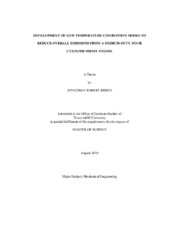| dc.description.abstract | Low temperature combustion (LTC) is an appealing new method of combustion that promises low nitric oxides and soot emissions while maintaining or improving on engine performance. The three main points of this study were to develop and validate an engine model in GT-Power capable of implementing LTC, to study parametrically exhaust gas recirculation (EGR) and injection timing effects on performance and emissions, and to investigate methods to decrease pressure rise rates during LTC operation. The model was validated at nine different operating points, 3 speeds and 3 loads, while the parametric studies were conducted on 6 of the 9 operating points, 3 speeds and 2 loads. The model consists of sections that include: cylinders, ports, intake and exhaust manifolds, EGR system, and turbocharger. For this model, GT-Power calculates the combustion using a multi-zone, quasi-dimensional model and a knock-induced combustion model. The main difference between them is that the multi-zone model is directly injected while the knock model is port injected. A variety of sub models calculate the fluid flow and heat transfer.
A parametric study varying the EGR and the injection timing to determine the optimal combination was conducted using the multi-zone model while a parametric study that just varies EGR is carried out using the knock model. The first parametric study showed that the optimal EGR and injection timing combination for the low loads occurred at high levels of EGR (60 percent) and advanced injection timings (30 to 40 crank angle degrees before top dead center). The optimal EGR and injection timing combination for the high loads occurred at low levels of EGR (30 percent to 40 percent) and retarded injection timings (7.5 to 5 crank angle degrees before top dead center). The knock model determined that the ideal EGR ratio for homogeneous charge compression ignition (HCCI) operation varied from 30 percent to 45 percent, depending on the operating condition. Three methods were investigated as possible ways to reduce pressure rise rates during LTC operation. The only feasible method was the multiple injection strategy which provided dramatically reduced pressure rise rates across all EGR levels and injection timings. | en |


